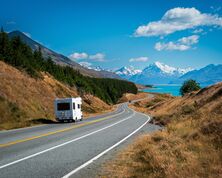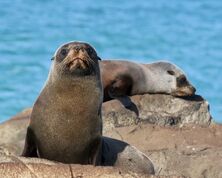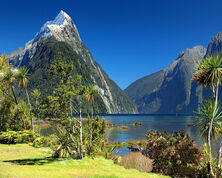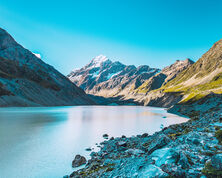
Departures: 23rd Jan 2027, 12th Feb 2027
from £8,149 pp.
Book your holiday today:
Within GB: 01580 214 089 • International: +44 (0)1580 214 089
Some of the best memories are made when we venture away from the norm and seek out the unusual. New Zealand is full of opportunities to really stretch your legs, with trails, cycle rides even white water rafting.
Our motorhome holidays can be built to your tastes, and these are just a small selection of the more unusual areas within New Zealand that you can travel to. Remember, your motorhome comes with unlimited mileage, and some even have a handy tablet to help you navigate your way and even book excursions direct.
Quick find guide
A remote coastal region located in the southeastern corner of the South Island, known for its rugged beauty and diverse wildlife
If you book our South Island Discovery tour, you'll be making your way down to Invercargill on days 7-9. A stop at the Catlin's is well recommended, known for diverse wildlife and lush rainforests.
Home to several stunning beaches, including Surat Bay and Porpoise Bay, the Catlins offer great opportunities for swimming, surfing and discovering some of the island's shipwrecks, such as the Manuka, The Surat and the Otago.

If you fancy exploring some of the caves, then the Cathedral Caves are accessible at low tide. Approximately 200 meters long and accessible by a short walk from the car park, it winds its way through native forest and along a boardwalk leading to the caves' entrance. Inside, you can admire the unique and intricate rock formations created over thousands of years by the sea.
The caves have high ceilings and large open chambers, with the natural light filtering through the cave openings, which help to create a truly magical atmosphere. Several native bird species, including the rare and endangered Yellow-Eyed Penguin, can be seen in the area.
Sorry, this map cannot be displayed.
The following consent is required:
Tracking & performance, Targeting & advertising.
Exploring the area further can lead you to the historic village of Kaka Point, with charming cottages and stunning coastal views. Take a picturesque bush walk or visit the charming town of Owaka, which is home to several art galleries and cafes. Alternatively, visit Purakaunui Falls, which are some of the most photographed waterfalls in New Zealand.
A small town located in the northwest of the South Island, known for its untouched wilderness and hiking trails.
Located on the North West coast of the Southern Island, Karamea is surrounded by the Kahurangi National Park and offers a peaceful and secluded area with stunning natural limestone formations.
The Karamea River has exceptionally clear water making it an excellent spot for fishing. With a lot of brown trout to trophy size, this river certainly can supply you with a great catch for an evening BBQ.

| Morning: |
Start your day with a delicious breakfast at one of the local cafes or restaurants, such as the Last Resort Take a short drive to the Oparara Basin and start your hike to the Oparara river and see the Oparara Arches, a natural limestone arch formation that is a must-see The hike is moderate in difficulty taking around two hours return. It is also possible to combine it with the Moria Gate Cave; take your camera for this one! Afternoon: |
Head back to Karamea for a well-deserved lunch and stroll around the town to see the charming local shops and art galleries. After lunch, take a drive to the Karamea River and try your hand at fishing or rent a kayak and explore the river. Evening: |
After a day of outdoor activities, unwind with a cold beer at the brewery and enjoy a hearty dinner at one of the local pubs or restaurants. End your day with a sunset walk along the beach and enjoy the stunning coastal views. |
Sorry, this map cannot be displayed.
The following consent is required:
Tracking & performance, Targeting & advertising.
The third-largest island of New Zealand, located south of the South Island
Stewart Island, also known as Rakiura, is New Zealand's third-largest island, located just off the southern coast of the South Island. It is known for its untouched wilderness, rugged landscapes, and abundant native wildlife.
Stewart Island is also great for experiencing New Zealand's southern lights, Aurora Australis, which are visible during winter. Additionally, it is a superb place for bird watching, fishing and kayaking.
If you fancy a multi-day trek, walking the Rakiura track is a perfect way to experience the sights and sounds of Stewart Island. As you wander the trails during the day, you'll be in sync with the rhythm of the island, and at night, the soothing sound of owls and the occasional kiwi bird call will lull you to sleep. This island is a haven for birds, and the population is abundant.

Despite having a small human population of less than 400, the island boasts a rich and unspoiled podocarp forest that serves as a sanctuary for native birds.
The Rakiura Track offers a variety of landscapes, from open coastlines to forested ridges and sheltered beaches. Most of the track is on boardwalks and features beautiful wilderness beaches, including the historically significant Māori Beach, which was once home to a Māori village and sawmill.
Sorry, this content can not be displayed.
The following consent is required:
Required cookies.
It's important to note that the Rakiura Track can be quite muddy and challenging, but it's all part of this famous trail's adventure and charm. With a little caution, the muddy crossings and walking in heavy, mud-soaked boots can be tackled, and the reward of the island's natural beauty is well worth it.
You can visit Stewart Island on our South Island Discovery and Ultimate New Zealand tour. For more information, visit our Island hopping blog article.
An archipelago located 800km east of the mainland, known for its unique wildlife, including the Chatham Islands black robin and remote beaches.
The Chatham Islands are a cluster of islands located in the Pacific Ocean, around 800 kilometres (500 miles) southeast of mainland New Zealand. The islands are known for their unique and diverse wildlife, including many species found nowhere else in the world.
The Chatham Islands have a rich history dating back to when the indigenous Moriori people first settled them. Later on, the islands were frequented by European whalers and Māori from the New Zealand mainland. Today, descendants of the Moriori still reside in the Chatham Islands.

Visiting Kopinga Marae is an excellent way to gain an understanding of the Moriori culture. The marae, a unique design resembling an albatross in flight, plays an important role in reviving the Moriori language, customs, and traditions. It is also a hub for community and school events and educational gatherings.
During your visit, you will have the opportunity to learn more about the Moriori people, including their ancient covenant of peace, and view intricate carvings and artwork. Additionally, you can visit the statue of Tommy Solomon (Tame Horomona Rehe), the last full-blooded Moriori, located in Manukau east of Owenga. This statue is a worthwhile stop and highlights the importance of preserving the island's history.
Sorry, this map cannot be displayed.
The following consent is required:
Tracking & performance, Targeting & advertising.
One of the most interesting creatures on the Chatham Islands is the Chatham Island black robin, a small bird that was once on the brink of extinction. Thanks to conservation efforts, the population of these birds has increased, and they are now considered a conservation success story.
Another unique species found on the Chatham Islands is the Chatham Island taiko, a flightless seabird. These birds are playful and curious and can often be seen waddling around the islands, looking for food.
The Chatham Islands are also home to various bird species, including the Chatham Islands oystercatcher. The islands are also a haven for seals, with New Zealand fur seals and Hooker's sea lions found on the beaches.
| Morning: |
| Start the day by taking a guided tour of the Chatham Island Taiko Reserve, where you can learn about the unique flightless seabird and see them in their natural habitat.
|
| Head to the Te Whanga Lagoon, a beautiful and peaceful spot where you can spot many bird species and seals. Take a short hike to the summit of Mount Hakepa, where you can enjoy panoramic views of the islands and the surrounding ocean. Finish the day with a visit to the Chatham Islands Museum, where you can learn about the history and culture of the islands and see exhibits showcasing the unique wildlife and plants that call the Chatham Islands home. |
A remote wilderness area located in the central North Island, known for its hiking trails, hunting and horse trekking opportunities.
Kaimanawa Forest Park is a remote and rugged wilderness area located on the central North Island of New Zealand. At over 33,000 hectares, the park is home to an incredible variety of plant and animal life and a rich cultural history.
There is something for everyone here, with an extensive array of activities available.

| Walking |
| There are plenty of trails ranging from easy walks to challenging tramps. The Kaimanawa Heritage Trail is a popular choice, a 35 km, multi-day hike that takes you through the park's most spectacular scenery and historic sites. The trail is well-marked and offers excellent camping options, with several huts and campsites along the way. Helicopter rides |
| Numerous operators can take you for a stunning flight over, Kaweka, Kaimanawa, Waioeka and many other places. From here, you can see the park's stunning alpine areas with rocky peaks and steep ridges. Rafting |
| With fast-moving rapids and tight turns, the Tongariro River, which winds its way through the heart of the park, is a popular choice. The upper section of the river, known as the "Tongariro Gorge," is considered a grade III-IV river and is perfect for experienced rafters looking for a challenge. A more relaxed experience can be had in the lower section of the Tongariro River, perfect for beginners and families. The rapids here are gentler, and the scenery is just as breathtaking, making it the ideal place to enjoy the park's beauty while still getting a taste of the excitement of rafting.
|
| Horse trekking is another popular activity in the park, with several companies offering guided trips through the wilderness. The park's remote location and rugged terrain make it an exceptional destination for horse trekkers, and its management has worked hard to ensure that the trails are well-maintained and safe for horse travel. |
Sorry, this map cannot be displayed.
The following consent is required:
Tracking & performance, Targeting & advertising.
One of the most striking features of Kaimanawa Forest Park is its diverse landscape, which ranges from lowland forest to alpine tussock grasslands. The forest is a mix of native and exotic trees, including towering rimu, totara, and kahikatea, and introduced species such as Douglas fir and larch. The park is also home to a wide variety of birdlife, including the endangered North Island kokako and the rare whio (blue duck).
The Kaimanawa Forest Park is also rich in cultural history, with much evidence of human habitation dating back centuries. The park is home to several Māori pa (fortified villages) and other historic sites, including the remains of a sawmill and a gold mining operation. The park also has a long history of use by the military, with several training camps and other facilities built in the area during World War II.
New Zealand has a lot to offer motorhome travellers who venture out off the beaten track. The above is a small selection, so if there is anywhere that you would like to visit or any excursions you wish to book, contact our expert team, who will be able to build a bespoke itinerary for you. Your perfect New Zealand motorhome holiday is a quick call or message away.






Peter Stannett
Content Writer
Peter is our content writer and SEO specialist, helping keep our content current and monitoring website traffic.
His content covers all four corners of the globe, across topics like activities, advice, food, culture and history.
More by Peter Stannett